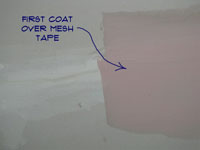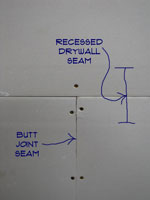 Coating drywall seams is the trickiest part of a taping job. Professionals can do it in four steps tape, first coat, second coat and sanding. For an amateur we have to add some steps, although they are not lengthy. It will go something like this: Tape, light sanding, First Coat, light sanding, Second Coat, light sanding, Skim Coat and Sanding.
Coating drywall seams is the trickiest part of a taping job. Professionals can do it in four steps tape, first coat, second coat and sanding. For an amateur we have to add some steps, although they are not lengthy. It will go something like this: Tape, light sanding, First Coat, light sanding, Second Coat, light sanding, Skim Coat and Sanding.
Until you develop a feel for working with drywall compound you will need the extra steps. Do not try to do too much with each coat. Also remember that drywall mud is mixed with water. When the water evaporates the mud shrinks. Taping mudding drywall is easier when you are patient.
Types of Drywall Seams
There are two types of drywall seams that are encountered with taping mudding drywall. The easiest to deal with is called a 'flat'. Along the long dimension of the drywall there is a 'recess' rolled into edges of the drywall. This provides a depression for the mud and tape when two recess edges are next to each other. These joints are much easier to finish and are naturally flat when done.
The depression created by the recess allows the mud and tape to finish flush with the face of the drywall. This allows you to get a flat surface when the sanding is done.
Unfortunately, for repair work you are always faced with a 'butt' joint. For a 'butt' joint the mud and tape go on top of the flat surface and have to be feathered in. Poorly done butt joints will show even after a wall is painted.
 That is why it is important to keep the tape and the build up of compound as tight as possible. Just try to keep it in your mind that a drywall joint is like a mountain range on your wall. The lower the height of the range and the wider and flatter the slopes, the less visible it will be.
That is why it is important to keep the tape and the build up of compound as tight as possible. Just try to keep it in your mind that a drywall joint is like a mountain range on your wall. The lower the height of the range and the wider and flatter the slopes, the less visible it will be.
How To Coat Drywall Joints
At this point you lightly sand the joint. The idea is to just knock the lumps off so that your successive coats will go smoothly. It only takes a few seconds to brush off a seam or joint. Those few seconds are well worth it. You'll be sorry if you don't listen about this.
For coating drywall seams, I like to use a six or an eight inch knife. One swipe down each side of the crack with a six inch knife is usually good for the first coat. You want to apply a coat of about and eighth of an inch of mud, maybe a little more over the entire patch or joint. The mud should go past the edge of the tape by a couple of inches. You want to take a trimming pass on the edges of the mud. The idea is to flatten or feather the edge so that the mud will not ooze out around the knife when you pull it. With the mud applied pull the knife down each side of the crack with the corner of the knife on the flat portion of the wall staying tight to the surface. Let the other side of the knife ride up off the center of the crack so that a coating of mud stays over the tape.
When you are done, can you see the tape? No, that's good. Yes, you pulled it too tight try again. The idea is to get just enough mud over the tape so that you have a surface to work to for the next coat. You don't want a small mountain but you do want at least a sixteenth of an inch of mud over the tape. Now walk away and let it dry, don't mess with it anymore. Did you hear me? Walk away, you'll only make it worse.
It gets easier from here. Hit the seam or joint again with the sanding sponge to get rid of any ridges or lumps. Select a knife that is two inches wider than the one you did the first coat with. Each coat should go out onto the flat surface slightly farther than the last. Remember the mountain range, your taping mudding drywall range is about and eighth of an inch high. Ideally the slope will be eight to twelve inches wide.
By getting the tape covered with and even coat of mud you have established a high point for your patch or joint. The wall surface is the low point. The idea with this coat is to fill the voids left by the shrinking mud. You do not want to put anymore build up on the patch. Run the knife down each side of the patch keeping it tight as you go.
How does it look? Smooth and even? Good, walk away and let it dry. See some voids, try it again. With the second coat applied you will need to wait for it to dry. The drying time should be less. Don't worry, you're almost done with coating drywall seams.
Brush off the patch with the sanding sponge and use mud that is fairly loose (extra water in it) to skim the patch. Keep the knife tight against the surface. You are only filling in the last of the voids. The seam or joint won't take much mud at this point. It is this final skim coat that will get your taping mudding drywall projects looking as good as a pro's do. Wait for the mud to dry and use the sanding sponge to do a final sand. Check it with your hand to make sure it is smooth. If you feel any lingering imperfections, you can hit them again with some drywall mud. Satisfied?
The added sanding and the extra skim coat will give you a fighting chance at a really professional looking patch. Coating drywall seams is not that satisfying if it looks bad after it is done. Of course once everything is painted the sign of a good taping job is that you don't notice it.
Taping Screws and Nails

Taping screws and nails is a necessary part of a drywall taping job. This is the easiest thing to do when taping mudding drywall. Screws leave a deep depression in the drywall. For this activity, you want to use mud that is a little stiffer. Thin mud will shrink too much when coating.
Always put three coats of mud on them. Fill the screw or nail with mud and drag the knife across it, keeping it tight to the surface of the wall. When done, you will sand the surface flush with the wall. You should not leave a build up of mud around the screw head.
If a screw is too high, get a drill and run it in until the head is below the surface of the wall. Do not try to build up mud around the screw head. This will leave an ugly blotch on your wall. Nails can be knocked in with a hammer or the handle of your drywall knife.
That's all there is to taping drywall screws and nails. Not that hard.

